- Details
- Hits: 1192
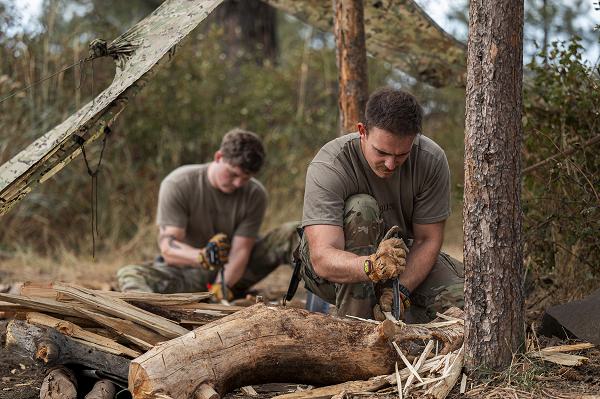
Fairchild Air Force Base, Washington. (October 17, 2024): Since World War II, American air crews have been captured, brutalized, and exploited by our enemies. In this photo by Senior Airman Tiffany Del Oso, Airman 1st Class Joe Trybus and Airman 1st Class Benathan Deman participate in Survival Escape and Evasion (SERE) training conducted by the Air Force’s 66th Training Squadron. In this phase of their training, SERE students are taught techniques to adapt to their surroundings to survive. This is the “evasion” part.
What is expected of an American warfighter if captured? This is the resistance part, and by far the most difficult both physically and emotionally. The need for escape and evasion training has its origins in the number of allied pilots downed over the skies of Germany. The training has been expanded in recent years due to the extreme mistreatment of POWs by our adversaries. During the Korean War, enemy prisoners were beaten and publicly displayed for propaganda purposes. In Vietnam’s infamous Hanoi Hilton prison, GI’s were subject to years of torture, starvation, and degradation.
- Details
- Hits: 1327
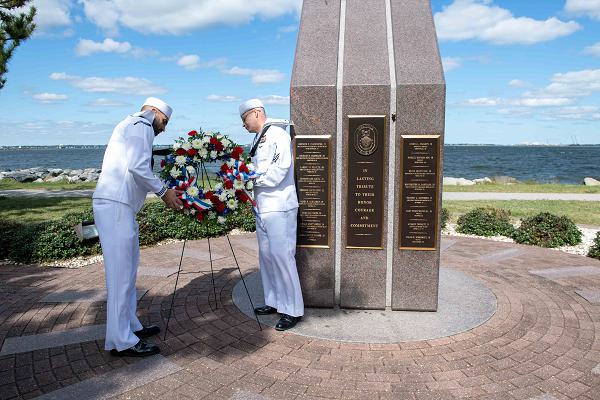
Norfolk, Virginia. (October 10, 2024): It has been twenty-four years since terrorists attacked the USS Cole, killing seventeen Sailors and wounding dozens of her crew, and the pain has not subsided. In this photo by MC1 Sophie A. Pinkham, Logistics Specialist 2nd Class Wilfredo Cerezo-Rodriguez and Logistics Specialist 1st Class Robert Jordan lay a wreath commemorating the victims at the USS Cole Memorial.
On October 12, 2000, al-Qaeda terrorists detonated a bomb alongside the USS Cole while it was refueling in Aden Harbor, Yemen. Two men pulled up alongside the vessel in a motorboat, reportedly making friendly gestures to the American warship. They then detonated 1,000 pounds of explosives. The blast killed seventeen and injured thirty-nine crew members and created 40-foot hole in the side of the ship. The crew fought valiantly for more than 96 hours to rescue their shipmates and save their ship under extremely dangerous conditions.
- Details
- Hits: 1979

Andaman Sea. (October 12, 2024): A warship is like a living being, its key parts must be ready to spring to life in an emergency. In this photo by MC1Greg Johnson, Operations Specialist 1st Class Ruchel Papa, from Los Angeles, stands watch in the combat information center during a General Quarters drill aboard the Arleigh Burke-class guided-missile destroyer USS Dewey. General Quarters is a ship-wide signal that all hands (everyone available) aboard must go to battle stations (the positions they are to assume when the vessel is in combat) as quickly as possible. The emergency could be enemy sightings but the command is also used to summon the crew during storms or even fog.
The order traces its roots to the British Navy phrase 'beat to quarters' which indicated a particular kind of drum roll that ordered sailors to their posts. In preparing for a fight, some would load and prepare to fire the ship's guns while others would ascend the rigging as sharpshooters. During general quarters, crew members would remain at their battle stations with their guns and ammunition ready for immediate use.
- Details
- Hits: 1116
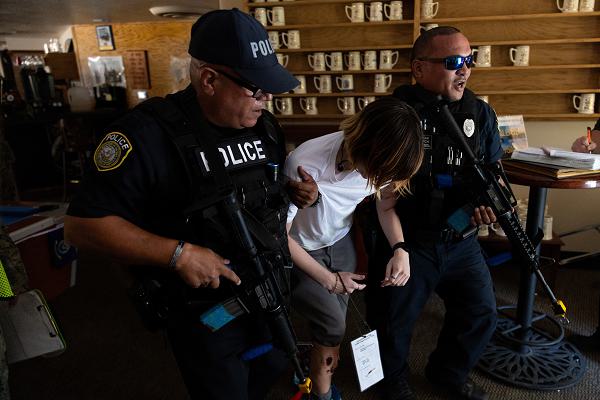
Naval Air Station Pensacola, Florida. (October 19,2024): In years past, Americans have assumed attacks happen “over there”, thousands of miles away from the “home front”. No longer. In this photo by Garrett Dipuma, Pensacola Naval Security Forces escort a “gate jumper” during a readiness exercise to evaluate base security. Today’s threats to Navy installations include intruders, drone swarms, civilian protests, cyber hackers, disinformation campaigns, and attacks on power sources. Unfortunately, technical advances have brought these threats closer to home.
Each year, Naval Installations Command runs exercises like these to evaluate how well regional installations work with local agencies to confront these threats. In addition to joint patrols and information exchanges, base security officials have added high tech enhancements, such as robot patrol vehicles, to expand security coverage. This year, special attention is being placed on the threat posed by drone aircraft to critical installations. These cheap, readily available aircraft have been used to gather intelligence or conduct direct attacks on U.S. facilities.
- Details
- Hits: 1397
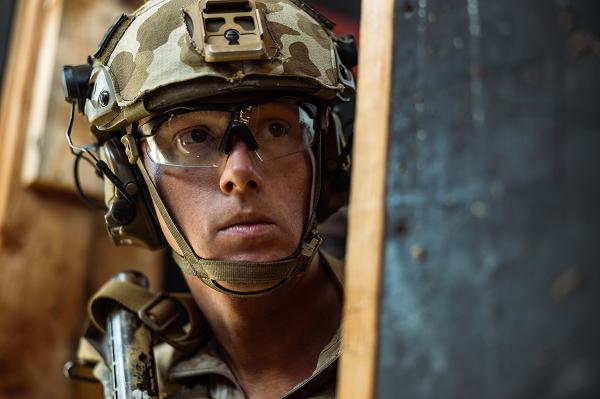
Camp Pendleton, California. (October 15, 2024): From fighting door-to-door in World War II to clearing rooms in Iraq, the Marines have a long and tortured history with urban warfare. In this photo by Lance Corporal Jordan Searls, Sergeant Trent Hau assesses his surroundings prior to conducting a room clearing drill during the Marine Raid Leaders Course. Operated by the Marine’s Expeditionary Operations Training Group, the course teaches Marines and Sailors how to survive urban combat.
During World War II, Army Soldiers cleared buildings all the way to Berlin and the Marines fought it out in the cities of Hue, Vietnam. Recent experience in Fallujah, Iraq, has underscored the need for more training in close quarter combat. Due to its chaotic, claustrophobic nature, urban combat is perhaps the deadliest chore in the infantry.
Raiders seize buildings by breaching doors and going room-to-room to root out the enemy. They are most vulnerable when attempting entry so each raid begins by “setting” security and establishing a perimeter. Next, Raiders practice dozens of entry methods using tools, chemicals, and explosives. Once inside, the troops learn how to safely sweep a building in which the enemy could be anywhere. Confronting these dangers requires nerve, training, and constant practice.
The Marine’s Raid Leader course teaches the lessons learned in past conflicts by current urban combat veterans of Iraq and Afghanistan as instructors. In extremely realistic simulations, the two-week program teaches students how to breach structures, clear rooms, and the rules regarding detaining non-combatants.
- Details
- Hits: 1192
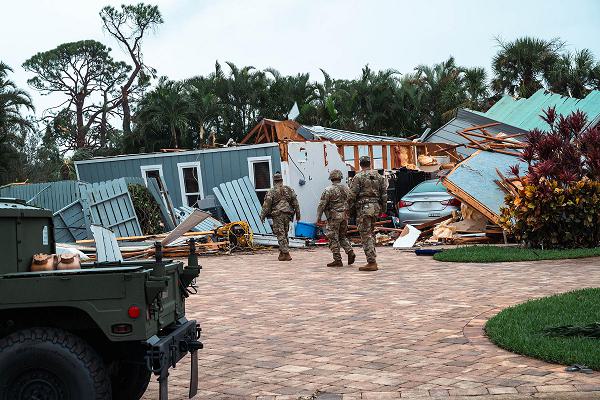
Stuart, Florida. (October 12, 2024): Just when the National Guard thought it had its hands full with Helene, along comes Milton, a Category 3 hurricane which slammed into Florida this week. In this photo by Major Cammy Alberts, Florida, and South Carolina National Guard Soldiers search for residents in need of assistance in this tiny coastal city. Tornadoes spawned by the storm decimated areas of Stuart as Milton progressed across the state.
At least fourteen deaths have been attributed to the hurricane which left 3.4 million Floridians in the dark. The storm came ashore seventy miles south of Tampa with maximum sustained winds of 120 mph that triggered dozens of tornados. The storm cut a path of death and destruction through the middle of the peninsula with damages estimated to be over 1.9 billion according to the Florida Office of Insurance Regulation. Of the seven deadliest hurricanes since 2000, four have hit Florida.
As of Sunday, over 7,600 Guardsmen from nineteen states helped rescue hundreds of people threatened by flooding in and around the Tampa area. Crews used two helicopters, 590 high-water vehicles, and thirteen boats to pull people to safety. Guard teams also cleared roads, distributed food, and water, and helped provide security. Many of the hardest hit areas had large elderly populations that needed immediate assistance after the storm. Many Florida residents credit the Guard for quickly clearing roads for first responders so they could reach storm victims faster.
The Guard operates under the Emergency Management Assistance Compact which is a state-to-state mutual aid agreement. The recovery from both Helene and Milton will be a long one but rest assured America’s National Guard will be there.


